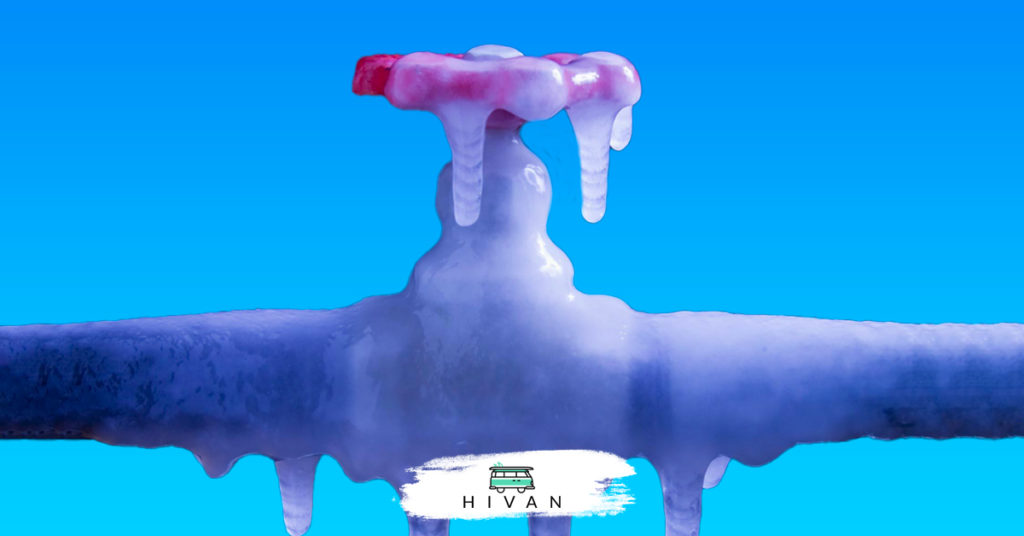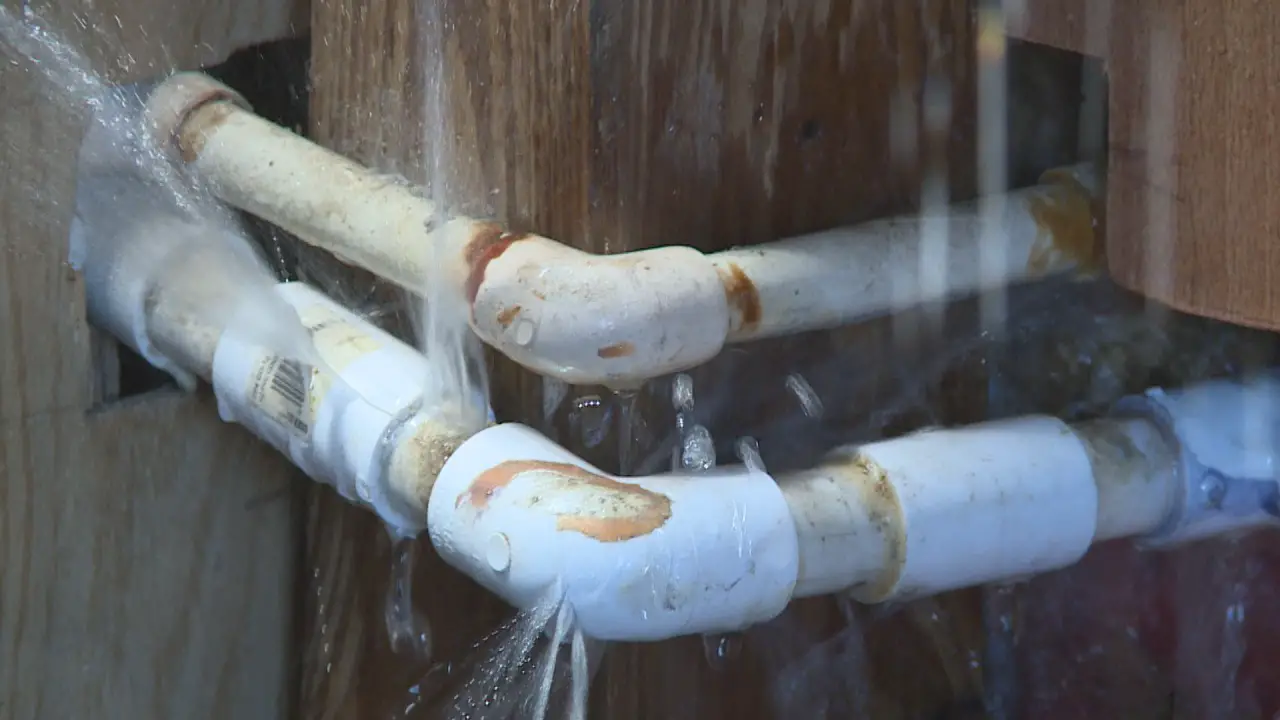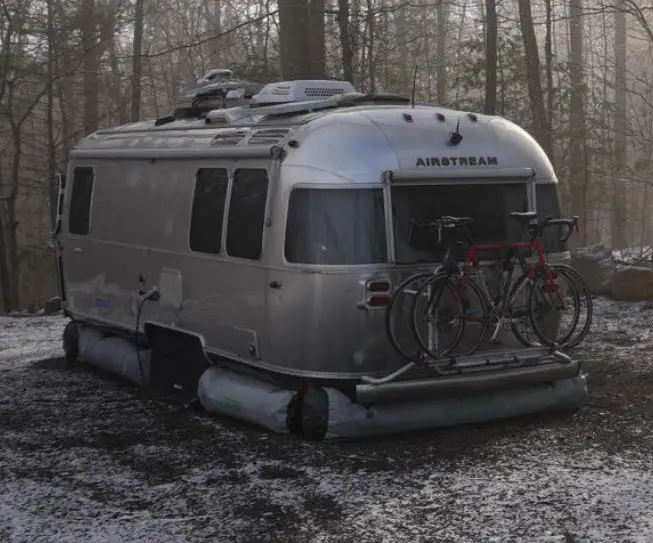Camping or storing an RV during cold weather can be problematic. You have to worry about the pipes, holding tanks, propane, and other equipment. Frozen pipes and holding tanks are susceptible to all sorts of potentially expensive issues. Fortunately, there are many ways to prevent it from happening. Damaged pipes from the ice could totally ruin your van build and stop your van life.
If RV pipes freeze, you won’t be able to run water to the sink, shower, or toilet. Frozen pipes can loosen the unions when they thaw or crack, leading to leaks in hard-to-reach places. To prevent your RV’s pipes from getting too cold, run the water at a slow drip or warm them with insulation tape.
In this article, we will explore practical steps you can take to prevent your RV’s pipes from freezing while camping or during Winter.
By adopting a few precautionary measures, you can enjoy your trip without worrying about frozen pipes or the associated hassle and expenses.
Stay warm and ready with these useful tips, allowing you to fully focus on creating unforgettable memories with your loved ones under the starry sky.

What Happens If Your RV’s Pipes Freeze?
Letting your RV’s water pipes freeze is never a good idea. Many first-time owners neglect to protect their RV if they’re storing it for the winter. It might be tempting to let it ride through the season, but repeatedly freezing the pipes will inevitably cause irreparable damage.

So, what happens if an RV’s pipes freeze?
- Frozen pipes can crack or loosen if they get too cold for too long. Water expands and contracts when it thaws and freezes, making it difficult for the pipes to keep up. Twisted or glued unions will warp and bend until they can’t anymore. This process can make them crack, leak, and need replacements.
- You won’t be able to use the water connected to any of the pipes. RV Share shows the most common symptom of frozen pipes in an RV is the water won’t flow. If it’s cold outside and nothing is coming through the pipes, they might be frozen. However, don’t forget to ensure there’s enough water in the holding tank before worrying about it.
- If the water expands, it could ruin the water pump. Water pumps have seals, gaskets, motors, and many other components that frozen temperatures can damage. If the pipes freeze and the motor keeps running dry, it’ll strip the bearings and grind until it can’t work anymore.
Frozen RV pipes are quite annoying, but they’re not too difficult to handle if you catch them early enough. The trick is to know how cold the RV’s pipes can get before they freeze. If you can keep the pipes warm enough, you’ll never have to deal with any of these problems. Read on to learn what you should do.
At What Temperature Can Motorhome Pipes Freeze?
How are you supposed to know if your RV pipes are in danger of freezing? Water freezes at 32 degrees Fahrenheit (0 degrees Celsius), but that range might not affect your pipes if they’re insulated. Nevertheless, it’s wise to prepare the pipes to freeze when the night gets too cold for too long.
RV Pipes Typically Freeze Around 32 Fahrenheit or 0° Celsius
According to RV Blogger, your RV’s pipes become much more in danger when water begins to freeze. Please turn on the water every couple of hours to ensure it’s still able to run. If it’s not coming out of the sink faucet or showerhead, it might be time to try some of the tips found in the next section. You could also use a blow dryer on medium heat.
How Quickly Do RV Pipes Freeze?
Your RV’s pipes won’t freeze the second they hit 32 degrees Fahrenheit. Instead, it might take a couple of hours for them to develop frost. If you camp in a place that dips down to 32 F for an hour at night, you likely won’t have to worry about them freezing. Low temperatures and longevity are both required to freeze your vehicle’s pipes.
As you can see, RV pipes don’t freeze too often. However, it’s best to be prepared for the worst-case scenario. If you’re worried about your RV’s pipes freezing on an upcoming trip or they’ve already gotten too cold, proceed to the next section to know how you can get them back in good condition.
Find this content useful 🙂 ?
Subscribe to our Newsletter and get a free Solar Electric Diagram + shopping list.
How to Keep RV Pipes From Freezing?
You’ve seen the expensive repair bills and frustrating issues frozen RV pipes can cause. If you don’t want to deal with either of these issues, it’s time to follow our four-step process to protect the pipes.
Here’s what you need to do:
Insulating RV Pipes
Properly insulating your RV pipes helps a lot to prevent them from freezing during cold weather camping.
Here are some methods and materials to consider when insulating your pipes.
First, identify all the exposed water lines in your RV, such as those under sinks, behind toilet tanks, and in the storage bays. You will want to focus on insulating these areas to reduce the likelihood of freezing.

One of the most effective and commonly used materials for insulating RV pipes is foam insulation.
The insulation is designed to prevent heat loss or gain and can be used on hot or cold pipes.
💡 It also helps to stop condensation on cold pipes, preventing water damage.
💡 The insulation is easy to install with pre-cut, self-sealing slits.
Available as tubes, foam pipe insulation can be easily cut to size and slid onto the water lines. This material is not only easy to work with but also provides heat retention and can help maintain a stable temperature within your pipework.
Closed-cell spray foam insulation is another option when it comes to insulating your pipes. This type of insulation offers excellent thermal resistance and has the added benefit of filling any gaps surrounding your pipes.
To apply closed-cell spray foam insulation, carefully follow the manufacturer’s instructions and safety guidelines.
![]() Keep in mind that using spray foam insulation may make it more difficult to access pipes for maintenance or repairs in the future.
Keep in mind that using spray foam insulation may make it more difficult to access pipes for maintenance or repairs in the future.
Lastly, maintaining an adequate temperature inside your RV is crucial to keep your pipes from freezing. Keep your interior temperature above 32°F(0°C) to avoid frozen pipes, and consider using space heaters for additional warmth in areas with exposed water lines.
Regularly check for drafts or gaps around windows, doors, and vents, and seal them as necessary to further insulate your RV.
Heating Methods to Unfreeze Your RV Pipes
When it comes to keeping your RV pipes from freezing, employing various heating methods can make all the difference. Here are several options that can help you maintain the temperature in your RV and prevent your pipes from freezing:
Heat tape
You can apply heat tape to your RV pipes to provide a consistent source of warmth. This prevents the internal temperature from dropping below freezing and helps avoid frozen pipes. Remember to wrap the tape around all exposed pipes for the best results.
![]() Double check that your pipes are not cracked before using heat tape.
Double check that your pipes are not cracked before using heat tape.
Designed for 3" pipe or elbows, this heater pad can be easily installed with its self-adhesive 3mm foam insulation pad.
💡 Easy Installation: This 2-wire heater pad can be wired to a 12V DC power supply and RV power switch for fixed-place installation.
Heating pads
Installing a tank heating pad is a practical solution for keeping your RV’s pipes warm. Attach the pad directly to the appliance or tank you want to keep warm, and it will work to maintain the temperature, preventing the water from freezing.
The space heater uses advanced PTC ceramic heating technology and an ultra-efficient fan to heat up spaces quickly and evenly.
🔀 The thermostat can be adjusted to maintain a comfortable temperature, ensuring your desired level of warmth.
Space heater
Using a space heater is an effective way to maintain a comfortable temperature inside your RV, which in turn, will help prevent your pipes from freezing. Place the heater close to the pipes and set it to a low or medium setting for optimal results.
![]() Keep in mind that electric heaters generally consume a lot of electricity. Make sure that your electrical setup can withstand it before buying one.
Keep in mind that electric heaters generally consume a lot of electricity. Make sure that your electrical setup can withstand it before buying one.

Furnace & Propane heater
Running your RV’s furnace during cold weather camping can help keep the interior temperature above freezing. This is important, especially if your freshwater lines run through the body of the RV or through the floor.
A propane heater can also be effective in keeping your RV warm enough to prevent pipes from freezing. Ensure you have an adequate supply of propane to last throughout your camping trip and position the heater near the pipes for maximum effectiveness.
The heat gun has an LCD display that allows the user to adjust the temperature in 50-degree increments.
💡 It has built-in overload protection to prevent burn-up.
Heat gun
While not a long-term solution, a heat gun can be useful in emergency situations when you need to thaw out frozen pipes quickly. Aim the gun at the frozen section of the pipe to gradually melt the ice and restore normal function.
![]() Remember to exercise caution and never apply excessive heat to avoid damaging the pipes or causing a fire.
Remember to exercise caution and never apply excessive heat to avoid damaging the pipes or causing a fire.
By employing these heating methods, you will be well-equipped to prevent your RV’s pipes from freezing during your camping adventures. Remember to choose the method that best suits your specific needs and preferences for optimal results.
Skirting Your RV for Winter Camping

When winter camping in your RV, skirting becomes an essential step to help prevent freezing of your pipes. Skirting helps to insulate the underside of the RV, which reduces the amount of cold air that can reach your pipes and tanks.
One option for skirting is to use thick vinyl or plastic sheeting. This material is relatively affordable and easy to install. Simply cut the sheeting to size and secure it around the base of your RV with weights or stakes. This will create a barrier against cold air, shielding your pipes from freezing temperatures.
Another option is to use foam boards, such as Styrofoam or R-Tech, for skirting. These provide more insulation than vinyl sheeting and can be cut to fit the contours of your RV. When using foam boards, secure them in place with tape, adhesive, or other fasteners. You can also add a foil face to the foam boards for extra insulation.
Inflatable RV skirting system that can be installed in minutes. Protect your RV!
Airskirting is a more advanced option, which features commercial-grade inflatable tubes that can be assembled around your RV’s perimeter. This type of skirting provides excellent insulation and durability, but may be more expensive.
Regardless of the material you choose, it is crucial to properly install your RV skirting to ensure adequate insulation and protection.
Be sure to cover the entire perimeter of your RV, closing off any gaps or openings. This will prevent drafts from sneaking under your RV and help keep your pipes from freezing during winter camping.
In addition, consider piling snow around the base of the RV once you have installed the skirting, which can further insulate and protect your pipes.
Insulate Water Tanks
Ensuring your RV’s holding tanks are protected from freezing while camping is crucial for a trouble-free and comfortable experience. Your RV has three holding tanks: fresh water, gray water (sinks + shower), and black water (toilet).
First and foremost, insulate your fresh water tank to keep it warm during colder temperatures and also cold enough to drink during hot Summers.
You can use foam board insulation, fiberglass insulation, or spray foam insulation to cover the tanks. It’s the same principles we explained to insulate your pipes.
Second, consider installing tank heaters or heating pads on your holding tanks. Electric tank heaters or heating pads can be attached directly to the bottom of the tanks, providing consistent warmth to prevent freezing.
Lastly, be prepared to take immediate action if temperatures suddenly drop. Keep a watch on the weather forecast and have plans in place to protect your holding tanks if needed. Acting promptly will help avoid potential damage and inconvenience from frozen holding tanks and pipes.
Draining and Preventing Burst Pipes

When camping in colder temperatures, it’s crucial to take measures to prevent your RV pipes from freezing. Frozen pipes can lead to cracks and eventually burst, causing extensive damage to your RV. Draining your RV’s water system is one way to minimize this risk. Here are a few tips to help you effectively drain and prevent burst pipes.
First, drain the water tanks. Emptying your holding tanks and freshwater tank will reduce the chance of water freezing inside the pipes. Make sure you do this when your RV is parked at a downward slope, helping gravity pull the water out more efficiently.
Next, protect the hot water heater by removing pressure from it and bypassing the connection. This will prevent potential damage caused by expanding frozen water inside the heater.
Check the water flow once you have done this to ensure there is no trapped water left in the pipes.
Using pipe insulation to cover exposed water lines and pipes under the RV can provide an extra layer of protection against freezing temperatures. This can be particularly useful if your RV’s freshwater lines run through the exposed underbelly.
Keeping the interior of your RV warm is another simple yet effective method to prevent pipes from freezing. A heated RV will make it harder for the cold air to reach and freeze the pipes running inside the RV’s body or floor.
In more severe freeze risks, you can also use non-toxic antifreeze to prevent water from freezing inside the pipes. Attach the antifreeze to your RV’s water system and turn on all water outlets until the antifreeze flows through.
![]() This step can be seen as a last resort, given the hassle of flushing the antifreeze out before using the water system again.
This step can be seen as a last resort, given the hassle of flushing the antifreeze out before using the water system again.
By following these recommendations, you will greatly reduce the risk of frozen pipes, cracks, and potential bursts, ensuring your RV adventures continue smoothly even in icy conditions.
Conclusion
Now that you know why RV pipes can’t get too cold, you can use one or more of the numerous tips found throughout this page. Frozen pipes can lead to costly repairs and prevent you from using the water. The good news is most frozen pipes go back to normal if they’re treated quickly enough.







